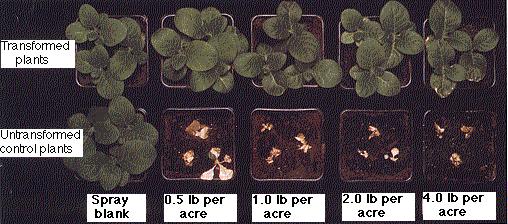Transgenic Plants
Progress is being made on several fronts to introduce new traits into plants using recombinant DNA technology.
The genetic manipulation of plants has been going on since the dawn of agriculture, but until recently this has required the slow and tedious process of cross-breeding varieties. Genetic engineering promises to speed the process and broaden the scope of what can be done.
Making transgenic plants
There are several methods for introducing genes into plants, including
- infecting plant cells with plasmids as vectors carrying the desired gene
- shooting microscopic pellets containing the gene directly into the cell.
In contrast to animals, there is no real distinction between somatic cells and germline cells. Somatic tissues of plants, e.g., root cells grown in culture,
- can be transformed in the laboratory with the desired gene
- grown into mature plants with flowers.
If all goes well, the transgene will be incorporated into the pollen and eggs and passed on to the next generation.
In this respect, it is easier to produce transgenic plants than transgenic animals.
Some Achievements
1. Insect Resistance.
Bacillus thuringiensis is a bacterium that is pathogenic for a number of insect pests. Its lethal effect is mediated by a protein toxin it produces. Through recombinant DNA methods, the toxin gene can be introduced directly into the genome of the plant where it is expressed and provides protection against insect pests of the plant.
2. Disease Resistance.
Genes that provide resistance against plant viruses have been successfully introduced into such crop plants as tobacco, tomatoes, and potatoes.
| Tomato plants infected with tobacco mosaic virus (which attacks tomato plants as well as tobacco). The plants in the back row carry an introduced gene conferring resistance to the virus. The resistant plants produced three times as much fruit as the sensitive plants (front row) and the same as control plants. (Courtesy Monsanto Company.) |  |
3. Herbicide Resistance.
Questions have been raised about the safety - both to humans and to the environment - of some of the broad-leaved weed killers like 2,4-D. Alternatives are available, but they may damage the crop as well as the weeds growing in it. However, genes for resistance to some of the newer herbicides have been introduced into some crop plants and enable them to thrive even when exposed to the weed killer.
| Effect of the herbicide bromoxynil on tobacco plants transformed with a bacterial gene whose product breaks down bromoxynil (top row) and control plants (bottom row). "Spray blank" plants were treated with the same spray mixture as the others except the bromoxynil was left out. (Courtesy of Calgene, Davis, CA.) |  |
4. "Terminator" Genes
This term is used (by opponents of the practice) for transgenes introduced into crop plants to make them produce sterile seeds (and thus force the farmer to buy fresh seeds for the following season rather than saving seeds from the current crop).
The process involves introducing three transgenes into the plant:
- A gene encoding a toxin which is lethal to developing seeds but not to mature seeds or the plant. This gene is normally inactive because of a stretch of DNA inserted between it and its promoter.
- A gene encoding a recombinase - an enzyme that can remove the spacer in the toxin gene thus allowing to be expressed.
- A repressor gene whose protein product binds to the promoter of the recombinase thus keeping it inactive.
How they work
When the seeds are soaked (before their sale) in a solution of tetracycline
- synthesis of the repressor is blocked
- the recombinase gene becomes active
- the spacer is removed from the toxin gene and it can now be turned on.
Because the toxin does not harm the growing plant - only its developing seeds - the crop can be grown normally except that its seeds are sterile.
The use of terminator genes has created much controversy:
- Farmers - especially those in developing countries - want to be able to save some seed from their crop to plant the next season.
- Seed companies want to be able to be able to keep selling seed.
5. Transgenes Encoding Antisense RNA.
17 April 1999


